


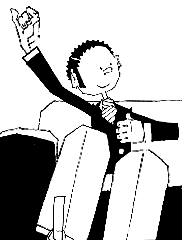
|

|
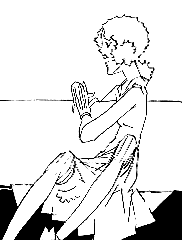
|
| Few artists define an age as thoroughly as John Held Jr. defines the "Roaring Twenties." Born in 1889, he was the right age at the right time with an outlook and sense of humor that shaped as well as recorded a generation. |
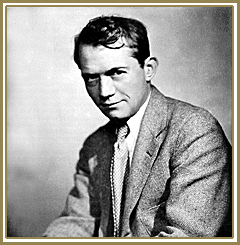
|
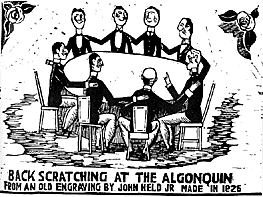 Another
child prodigy, as it seems so many of these pages record, Held
supposedly sold his first drawing at age nine. It's certain that
he sold his first drawing to the original Life magazine
at fifteen and was hired as the sports cartoonist for the Salt
Lake City Tribune when he was sixteen. His early medium of
choice was the wood block, which he returned to in various guises
several times. This is fortunate for us, as much of his published
and most famous work is done in an energetic but very fine line
that the web has trouble reproducing in moderately-sized files.
A 1926 sample is at right.
Another
child prodigy, as it seems so many of these pages record, Held
supposedly sold his first drawing at age nine. It's certain that
he sold his first drawing to the original Life magazine
at fifteen and was hired as the sports cartoonist for the Salt
Lake City Tribune when he was sixteen. His early medium of
choice was the wood block, which he returned to in various guises
several times. This is fortunate for us, as much of his published
and most famous work is done in an energetic but very fine line
that the web has trouble reproducing in moderately-sized files.
A 1926 sample is at right.
Much as I respect the talent, these are not the Held images
that attract me and though he worked in wood and linoleum prints
often, he was capable of much more. He studied art only briefly
in his teens with sculptor Mahonri Young. In 1912 he went East
and relocated in New York. One of his flatmates was Marc Connelly,
a playwright who is probably caricaturized in the Algonquin cartoon
above. In the excellent book, The Most of John Held Jr,
his introduction provided me with my best insight into Held's
sense of humor.
When we entered World War I in April, 1917 (Ernest) Haskell was commissioned to help develop the new science of camouflage. I remember the astonishment of John, Hal (Burrows) and myself one day that summer when Haskell, on leave, told us the remarkable achievements of the Camouflage Corps.
"We can paint battleships in such a way that at sea they seem invisible a mile away, or even less. We're also devising camouflage of artillery concealment and even uniforms. Come over to my flat and I'll show you a raincoat a Heinie can't recognize two hundred yards away.
Haskell left his living room a moment and reappeared wearing a doughboy helmet and raincoat, both painted with a dadaistic confusion of reds, greens, yellows, blues, and browns. He stood about 6'2" and now gave the appearance of a nightmarish Pierrot. While the rest of us stared at his weird appearance, John stretched out his hands like a man groping in the dark
"My God!' John cried, "Where's Ernie?"

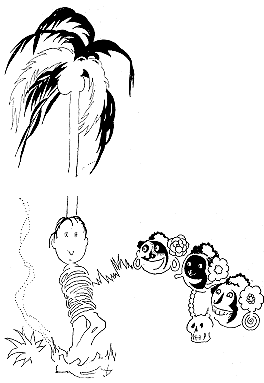 Those
early days in New York were spent doing ads and trying to break
into the magazine market. In 1915, he was appearing in Vanity
Fair, but was signing the work with his wife, Myrtle's, name.
The earliest work I have is from 1917 in the January issue of
House and Garden where he did an ad for Judge. In the February
issue, he did the heading for the section of the magazine devoted
to ads for dogs. (see above). In 1918 he was recruited by U.S.
Naval Intelligence to accompany a pair of archaeologists on an
expedition to Central America. Purportedly sent to study Mayan
art forms, Held's real job was to sketch the coastline and scout
for sites for military operations. He spent most of the time developing
his cartooning skills and honing a sophisticated edge on his humor.
Those
early days in New York were spent doing ads and trying to break
into the magazine market. In 1915, he was appearing in Vanity
Fair, but was signing the work with his wife, Myrtle's, name.
The earliest work I have is from 1917 in the January issue of
House and Garden where he did an ad for Judge. In the February
issue, he did the heading for the section of the magazine devoted
to ads for dogs. (see above). In 1918 he was recruited by U.S.
Naval Intelligence to accompany a pair of archaeologists on an
expedition to Central America. Purportedly sent to study Mayan
art forms, Held's real job was to sketch the coastline and scout
for sites for military operations. He spent most of the time developing
his cartooning skills and honing a sophisticated edge on his humor.
 Some
of that humor can be seen at left from a 1921 issue of Century
Magazine, and at right from a 1927 issue of a new magazine
called The New Yorker. Harold Ross, who started the magazine
in 1925, was a boyhood friend and Held created a feature called
Gay Nineties which poked gentle fun at the previous
generation. Done in linoleum cuts, these images have come to symbolize
the era almost as much as his flappers are associated with the
Twenties.
Some
of that humor can be seen at left from a 1921 issue of Century
Magazine, and at right from a 1927 issue of a new magazine
called The New Yorker. Harold Ross, who started the magazine
in 1925, was a boyhood friend and Held created a feature called
Gay Nineties which poked gentle fun at the previous
generation. Done in linoleum cuts, these images have come to symbolize
the era almost as much as his flappers are associated with the
Twenties.
Seldom have two generations experienced such a gap. Mothers who grew up with those petticoats and hoopskirts must have looked at their flapper daughters and wondered how they could have gone so wrong. Held thought they were so right. In popular magazines like Vanity Fair, Harper's Bazaar and Redbook, his images of Betty Coed and Joe College were placed weekly before an adoring public of parents who longed to see some humor in the situation and the teen-age and college crowd who looked to them as role and style models. Life (late 1920's) below left. The skirts were never quite that short, nor were the sheiks quite so pencilnecked, but everyone wanted to believe that they were. Held's images reassured their delusions.

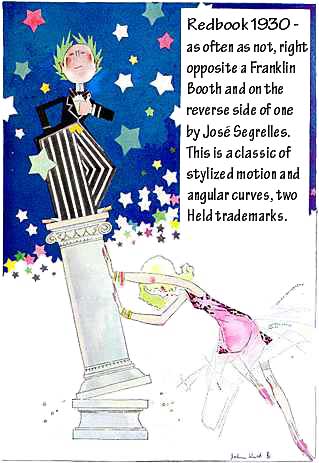
Held could do no wrong. People would send him blank checks begging for an original drawing. In the latter half of the decade he appeared regularly in a half-dozen magazines, designed sets and costumes for Broadway plays, had two newspaper strips [Margie and Rah Rah Rosalie] and ran for Congress. In 1930 he wrote Grim Youth and had his famous woodcuts for The Saga of Frankie and Johnnie published in a limited edition. They turned up a generation later in the first issue of a new magazine called Playboy.
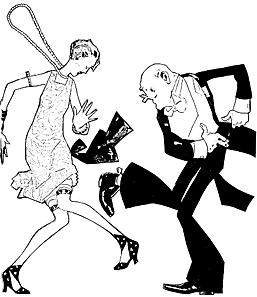 The
early 30's proved more difficult. The demand for the flapper art
was diminishing. Times changed. He lost a lot of money in a swindle
and had a nervous breakdown. He second marriage also ended in
divorce. He turned more to writing and illustrating books. Dog
Stories, I'll Tell My Big Brother, and Grim Youth
were all published in 1930, The Flesh is Weak in 1931,
Crosstown in 1933. His work continued in magazines, notably
Cosmopolitan, until at least 1934. In 1937 he did the sets
for Hellzapoppin, a very successful Broadway show.
At the end of the decade, the market for his woodcuts and flappers
was gone. He turned to sculpture and was the "artist-in-residence
at both Harvard and the University of Georgia at different times
in 1940.
The
early 30's proved more difficult. The demand for the flapper art
was diminishing. Times changed. He lost a lot of money in a swindle
and had a nervous breakdown. He second marriage also ended in
divorce. He turned more to writing and illustrating books. Dog
Stories, I'll Tell My Big Brother, and Grim Youth
were all published in 1930, The Flesh is Weak in 1931,
Crosstown in 1933. His work continued in magazines, notably
Cosmopolitan, until at least 1934. In 1937 he did the sets
for Hellzapoppin, a very successful Broadway show.
At the end of the decade, the market for his woodcuts and flappers
was gone. He turned to sculpture and was the "artist-in-residence
at both Harvard and the University of Georgia at different times
in 1940.
He painted throughout his life and the very enjoyable The Most of John Held Jr contains many of his urban and rural watercolors. His more mannered paintings often bore the mark of his cartooning, but he was adept at many styles and approaches. Arguably his most famous book, Held's Angels, appeared in 1952 written with Frank B. Gilbreath Jr. Back were the raccoon coats, the short skirts, bobbed hair and the Charleston. The very same style and characters that made him famous were now nostalgia, much in the manner of his Gay Nineties images of 25 years before. "Teaching an old dog new tricks" (above right) was as anachronistic in 1952 as his Gibson Girl parodies were in 1925 - and equally as accurate and entertaining.
Held died in 1958.
 To learn more about John Held, Jr, see:
To learn more about John Held, Jr, see:| The Most of John Held Jr | Foreword by Marc Connelly, 1972 Stephen Green Press |
| The Vadeboncoeur Collection of Knowledge | Jim Vadeboncoeur, Jr. 1998 |
|
Illustrations are copyright by their respective owners. This page written, designed & © 1998 by Jim Vadeboncoeur, Jr. Updated 2011. |
